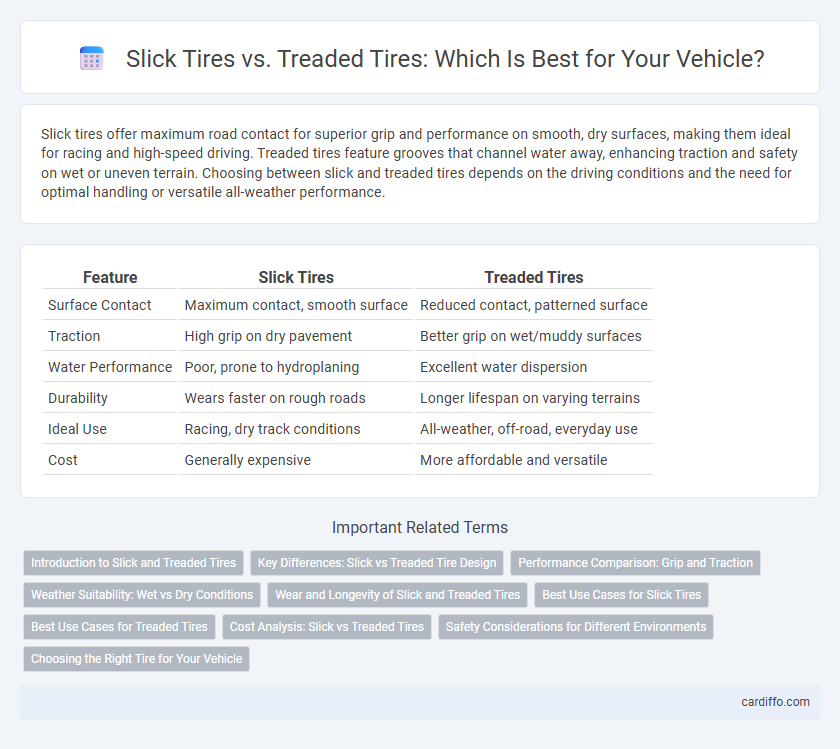Slick tires offer maximum road contact for superior grip and performance on smooth, dry surfaces, making them ideal for racing and high-speed driving. Treaded tires feature grooves that channel water away, enhancing traction and safety on wet or uneven terrain. Choosing between slick and treaded tires depends on the driving conditions and the need for optimal handling or versatile all-weather performance.
Table of Comparison
| Feature | Slick Tires | Treaded Tires |
|---|---|---|
| Surface Contact | Maximum contact, smooth surface | Reduced contact, patterned surface |
| Traction | High grip on dry pavement | Better grip on wet/muddy surfaces |
| Water Performance | Poor, prone to hydroplaning | Excellent water dispersion |
| Durability | Wears faster on rough roads | Longer lifespan on varying terrains |
| Ideal Use | Racing, dry track conditions | All-weather, off-road, everyday use |
| Cost | Generally expensive | More affordable and versatile |
Introduction to Slick and Treaded Tires
Slick tires feature a smooth surface without grooves, maximizing the contact area with the road for enhanced grip on dry tracks, making them ideal for racing and high-performance driving conditions. Treaded tires incorporate patterned grooves designed to channel water away, improving traction and safety on wet or uneven surfaces. Understanding the fundamental differences between slick and treaded tires helps optimize vehicle performance tailored to specific driving environments.
Key Differences: Slick vs Treaded Tire Design
Slick tires feature a smooth surface free of grooves, maximizing the contact patch with the road for superior grip on dry pavement, ideal for racing conditions. Treaded tires incorporate deep grooves and patterns to channel water away, enhancing traction on wet or uneven surfaces and reducing hydroplaning risks. The choice between slick and treaded tires depends on driving conditions, with slicks excelling in dry performance and treaded tires offering versatility and safety in variable weather.
Performance Comparison: Grip and Traction
Slick tires offer superior grip on dry surfaces due to their maximum contact area, enhancing acceleration and cornering performance in racing conditions. Treaded tires provide better traction on wet or uneven surfaces by channeling water away and maintaining contact with the road, reducing the risk of hydroplaning. Choosing between slick and treaded tires depends on the specific driving environment and performance priorities.
Weather Suitability: Wet vs Dry Conditions
Slick tires offer superior grip and performance on dry surfaces due to their smooth, treadless design that maximizes contact with the road. Treaded tires excel in wet conditions by dispersing water through grooves, reducing the risk of hydroplaning and maintaining optimal traction. Choosing between slick and treaded tires depends on typical weather patterns, with slicks ideal for dry climates and treaded tires better suited for rainy or variable weather.
Wear and Longevity of Slick and Treaded Tires
Slick tires offer superior grip on dry surfaces but tend to wear out faster due to the lack of tread, resulting in reduced longevity compared to treaded tires. Treaded tires feature grooves that provide better water dispersion and extended durability, making them more suitable for varied road conditions and longer lifespan. Proper maintenance and usage conditions significantly influence the wear rate and overall durability of both slick and treaded tires.
Best Use Cases for Slick Tires
Slick tires offer superior grip and maximum contact with smooth, dry surfaces, making them ideal for professional racing and track days where high-speed cornering and precision handling are crucial. Their lack of tread patterns reduces rolling resistance, enhancing acceleration and top speed on asphalt circuits. Slick tires perform poorly in wet or off-road conditions, so they are best used exclusively in controlled, dry environments for optimal performance.
Best Use Cases for Treaded Tires
Treaded tires excel in wet, snowy, and off-road conditions by providing superior traction and water dispersion, reducing the risk of hydroplaning and maintaining grip on uneven surfaces. Their deep grooves and siping patterns enhance handling and braking performance in adverse weather, making them ideal for everyday driving and variable terrain. This versatility ensures safety and control in diverse environments compared to slick tires, which are optimized for dry, smooth surfaces like racetracks.
Cost Analysis: Slick vs Treaded Tires
Slick tires generally have a higher initial cost due to their specialized rubber compounds and manufacturing processes, while treaded tires are more affordable and widely available. Over time, slick tires often require more frequent replacements because of faster wear on dry surfaces, leading to increased long-term expenses compared to the durable design of treaded tires. Maintenance costs also differ as slick tires demand precise care and storage to preserve performance, whereas treaded tires tolerate variable conditions and lower upkeep costs.
Safety Considerations for Different Environments
Slick tires offer superior grip on dry, smooth surfaces but significantly reduce traction in wet or slippery conditions, increasing the risk of hydroplaning. Treaded tires enhance safety by channeling water away and providing better traction on wet, snowy, or uneven terrains, making them ideal for varied weather conditions. Selecting the appropriate tire type based on environment is crucial to maintaining optimal vehicle control and accident prevention.
Choosing the Right Tire for Your Vehicle
Slick tires provide maximum contact with the road surface, enhancing grip and handling on dry pavement, making them ideal for racing and high-performance vehicles. Treaded tires feature patterned grooves that channel water away, reducing hydroplaning risk and improving traction on wet or uneven surfaces, which suits everyday driving and varied weather conditions. Selecting the right tire depends on your driving environment and performance needs, prioritizing slick tires for dry conditions and treaded tires for safety in wet or mixed terrains.
Slick tires vs treaded tires Infographic

 cardiffo.com
cardiffo.com